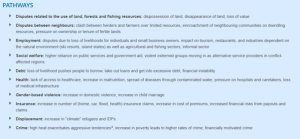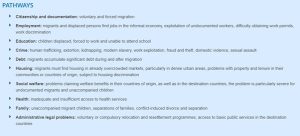1. Climate justice and legal needs
Climate change affects communities in both direct and indirect ways. Direct impacts include extreme weather events like cyclones, floods, heatwaves, and bushfires. The indirect and complex impacts are harder to identify but can have severe consequences for people’s lives and well-being. These complex impacts often lead to one or more legal problems for the affected individuals and communities.
This section explores the intersection of climate change and access to justice, highlighting the importance of accessible legal services to protect rights and promote resilience in the face of a changing climate by describing the work of active organisations.
Climate change impacts on access to justice
The Climate Justice Support Unit of the Federation of Community Legal Centres Victoria published a literature review examining how climate change impacts access to justice in the region. The review highlights the need to broaden our understanding of justice to address both biophysical and social injustices linked to climate change and extreme weather events. It identifies significant gaps in knowledge about these injustices and calls for new approaches to integrate climate justice into existing legal and policy frameworks. Further research is needed to understand systemic drivers of climate and disaster injustice, enhance the resilience of legal assistance organisations, and apply human rights principles to support transformative climate adaptation.
Part One: Context and Justice Frames
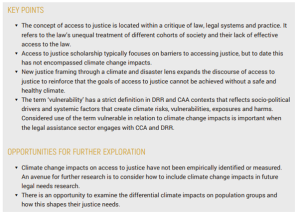
Part Two: Climate change impacts on access to justice
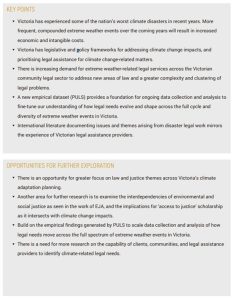
Part Three: Justice issues arising from climate change
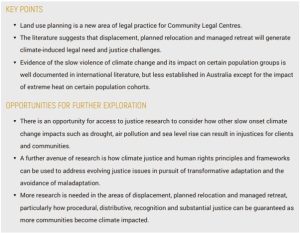
Part Four: Climate change impacts on access to justice
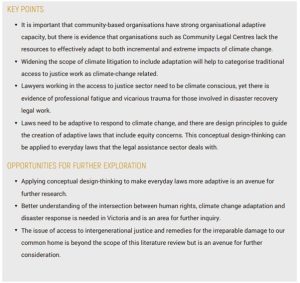
Climate change & access to justice – justice dashboard (international)
The Justice Dashboard provides an extensive policy brief with explanations about the intersection between Climate Change and Access to Justice. They propose policy initiatives and people-centred solutions and call on leaders to:
Their policy brief provides descriptions and pathways for climate trends on the demand for justice.
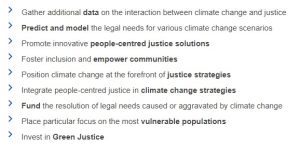
a. Loss of livelihood, food shortage and water insecurity due to severe weather events
Climate change is causing more frequent and severe extreme weather events like floods, hurricanes, and droughts, damaging infrastructure, crops, and livestock. This leads to greater food and water insecurity and pollution and negatively affects the livelihoods of billions of people who rely on agriculture and natural resources.
b. Displacement and migration
If immediate and coordinated action on climate and development isn’t taken, up to 216 million people might have to move within their countries by 2050 due to climate change. Currently, there are 108 million forcibly displaced people globally, and more than a third of the world’s population fears they might be forced from their homes in the next 25 years, with the most marginalised being from the least developed countries and island states.
c. Urbanisation and overpopulation of the less affected areas
Climate change will speed up urbanisation, particularly in Africa and Southeast Asia, where rapid growth is already happening. By 2050, an estimated 450 million people will move from rural to urban areas in Africa alone, straining cities with increased crime, pollution, and infrastructure demands and potentially exacerbating existing legal and social issues.
d. Human health risks
Climate change affects human health in many ways, leading to higher rates of death and illness from malnutrition, insect-borne diseases, and heat stress. Decreasing water and food supplies will worsen malnutrition, while air pollution from fossil fuels, wildfires, and indoor cooking is expected to become a major cause of death. Additionally, climate change will impact mental health, potentially increasing suicide rates and depression, regardless of socioeconomic status.
e. Escalation of conflicts between stressed populations
Conflicts between communities are already happening, and competition for scarce resources will only increase. Violence over dwindling food and water supplies threatens livelihoods, and countries with existing internal conflicts will struggle more with the social and economic impacts of climate change.
f. Transition to net zero economy
The Paris Agreement requires a 45% reduction in greenhouse gas emissions by 2030 and aims for net-zero emissions by 2050. This transition will lead to significant legal challenges, conflicts, and increased costs, impacting individuals, businesses, and economies worldwide.
The Climate Justice Legal Project
The Climate Justice Legal Project (Victoria) seeks to enable people who access Community Legal Centres to seek climate justice. They provide training and support for community lawyers to understand, identify and address the impacts of climate injustice. This is done by identifying issues within current services, institutions and laws and supporting communities to build agency and resilience.
“Climate disruption is increasingly disrupting access to justice. These barriers can be physical – like extreme weather making it difficult for Community Legal Centres to stay open despite people urgently needing help. Barriers to justice can also be less visible – like a lack of legal remedies for communities experiencing climate injustice. Our current laws and institutions were not designed by people dealing with the reality of climate change. Right now, these systems are failing to serve the diverse needs of many of us – and this, unless we redesign them, will only get worse as climate crisis intensifies.”
(The Climate Justice Legal Project)
Federation of Community Legal Centres
The Federation of Community Legal Centres is acting on Climate Justice. They offer an overall understanding of climate change and the law.
They consider the role of Community Legal Centres to uphold climate and disaster justice as a priority. Getting legal advice and comprehensive support is crucial for recovering after extreme weather events. This helps address immediate harm and prevents legal issues from getting worse. The rise in the frequency and severity of extreme weather events has greatly affected community legal sectors.
Examples of indirect impacts of climate change leading to legal problems
(Source: Community lawyering and climate justice: A new frontier Monica Taylor and Bronwyn Lay)
- Insurance and consumer law problems arise when consumer goods and properties become uninsurable.
- Tenancy law problems arise from disputes about heating and cooling and habitability during times of extreme heat or flooding.
- Employment law problems that result from climate impacts, such as unworkable conditions or workplace injuries due to excessive heat or flooding.
- Family violence law problems, which spike during disasters and extreme heat.
- Mental health law problems are often exacerbated during crises.
- Discrimination in recovery responses and procedures.
The Climate Justice Leadership Programme (CJLP) is guided by four overarching objectives aimed at addressing the need for systemic change, as well as organisational and practice adaptation within the community legal sector. These objectives include:
- Advocate for equitable and accessible climate solutions that address the root drivers of disadvantage and highlight the need for immediate cuts in emissions to protect the most marginalised.
- Amplify the voices, experiences and legal needs of those impacted by climate change, particularly the most marginalised.
- Ability to build the capacity of CLCs and integrated services to identify, anticipate and respond to legal needs arising from climate impacts.
- Adapt community legal services and legal practice to a climate justice model that embeds equitable adaptation practices and legal advice across the wider justice and legal sectors using collected evidence and data
(Source: Community lawyering and climate justice: A new frontier Monica Taylor and Bronwyn Lay)
Climate Justice: A rule of law approach for transformative climate action
The International Development Law Organisation established a policy brief in which they list the following seven rule of law-based policy recommendations.
- Enable climate-vulnerable communities and people
- Invest in people-centred laws and institutions to promote transformative climate action
- Champion feminist climate action and integrate gender-transformative approaches
- Strengthen prospects for sustaining peace and stability by preventing and resolving climate-related disputes
- Engage with customary, informal and indigenous justice systems to protect biodiversity and promote sustainable use of natural resources
- Harness the transformative potential of the rule of law to address the intersecting effects of climate change
- Mobilise global multi-stakeholder coalitions to accelerate climate action
2. Disaster and legal needs
Disasters, whether natural or human-made, often leave communities facing a range of legal challenges. From disputes over insurance claims to issues related to housing, employment, and personal safety, the aftermath of a disaster can be legally complex and overwhelming. This section addresses the critical role of legal support in helping individuals and communities navigate the legal needs that arise during and after a disaster, ensuring that they can recover and rebuild with their rights protected by providing links to resources and active organisations.
Legal aid information for natural disaster
This document from Legal Aid WA – Natural Disaster provides an overview of legal issues and support for people who have experienced natural disasters. There is over-the-phone or face-to-face advice available.
Legal Aid WA – Fact Sheet – Natural disaster
WA Post-Disaster Cultural Evaluation Framework
The WA Post-Disaster Cultural Evaluation Framework, developed by the Department of Communities in partnership with Bhiamie Williamson, aims to improve disaster recovery for Aboriginal and Torres Strait Islander Peoples by centring culture, healing, and wellbeing. Prompted by the Kimberley Flood recovery, the Framework addresses the need for inclusive monitoring and evaluation that acknowledges cultural needs and existing inequalities.
Climate disaster and legal problems
Community Legal QLD provides some resources for Community Legal Centres (CLCs) related to community resilience and disaster management, preparedness and recovery.
Webinar recording: Disaster legal assistance in 2023: insights from CLCs across the country
https://www.youtube.com/watch?v=yptriG6tMho
Diastere legal assistance 2023: insights from CLCs around the country
“There is no such thing as a ‘natural’
disaster: what we are responding to is the
result of anthropogenic climate change. It
is not weather but rather our systems,
laws, economics, politics and ways of
living that are causing increasing stress to
the planet and disasters.”
(Monica Taylor, CLCQ)
The Financial Rights Legal Centre has collected data to inform decision-making through data, numbers and figures to identify systemic issues, trends and case studies. The data has helped to expose insurance problems after extreme weather events. The General Insurance Code Governance Committee undertook a Thematic Inquiry into Making Better Claims Decisions, ASIC review found insurers can and should improve claims handling.
Getting prepared: A free self-help tool to help Australians save their
important documents
Justice Connect provides a self-help tool for storing documents in disasters.
If your important documents are lost, damaged, or hard to find quickly, it can cause extra stress at a time when you really don’t need it. Having quick access to these documents when you need them most can help you feel more prepared and secure. It can also make dealing with any legal issues after an emergency easier. While this resource isn’t directly related to climate, it may help organisations and individuals understand the steps and tasks needed to be better prepared.
3. Engage in advocacy
Engaging in advocacy is essential for advancing climate justice and addressing the legal needs that arise from disasters. By advocating for policy changes and equitable solutions, communities can ensure that their voices are heard and their rights are upheld in the face of climate-related challenges.
Access to legal resources
The Environmental Defenders Office provides legal resources to help people understand how the law applies to the environment and enable them to take action. There is an option to apply for legal advice. The resources designed for WA include local developments and private disputes, irrigation and water use, and others such as contaminated land or water, public participation processes, access to information, etc.
Find out more about access to justice within The Justice Project
The Justice Project is a detailed national review of access to justice in Australia. It focuses on the obstacles faced by people with significant social and economic disadvantages and identifies solutions that are working to reduce these obstacles. The Law Council aims to move beyond statistics and understand how access to justice issues affects the most marginalised people. Their goal is to create a fairer justice system in Australia. Guided by an expert Steering Committee, the Final Report is a thorough examination of the access to justice needs of marginalised Australians in recent years. The Report’s well-informed recommendations offer a plan for future action, advocating for new, government-wide justice strategies supported by proper funding.
Access to justice is about making sure everyone can use the legal system to protect their rights. It’s a key part of our democracy, which relies on the rule of law and human rights for all. However, the justice system doesn’t always work well for everyone. Some people, especially those in marginalised communities, find it harder to access justice.
Access to justice involves:
- Getting the right information about the law and how it applies to you.
- Recognising when you have a legal problem and knowing what to do about it.
- Receiving the right help with a legal problem, including from a lawyer.
- Being able to deal with your legal problem and understanding the outcome.
- Ensuring your voice is heard when laws are made.
Note: This resource is a little dated now, and there is no mention of extreme weather events or climate change as a driver of legal problems. However, it is a good framing to better understand access to justice.
Natural disaster-related legal needs in Australia
This state of the evidence report highlights several legal needs according to the natural disaster cycle (disaster preparation, disaster response, recovery support).
Find out more about Australia’s Human Rights in the context of Climate Justice at the Human Rights Law Centre
The vision of the Human Rights Law Centre is that Australian laws and policies tackle the climate crisis and prioritise the well-being of people and the planet in government decisions. The Centre works across Aboriginal and Torres Strait Islanders Peoples’ Rights, Migration Justice, Dignity for People in Prison, Corporate Accountability, Democratic Freedoms, Reproductive Rights, Human Rights Acts and Climate Justice.
Also visit: Climate Justice Advocacy and Campaigns
4. Aboriginal-led justice and legal needs
Since the first sunrise, Aboriginal and Torres Strait Islander Peoples have cared for Country and Culture, nurturing the land, waters, seas, and skies while honouring family, community, and ancestors. Today, despite centuries of colonial violence and destruction, Aboriginal and Torres Strait Islander communities continue to heal Country and fight for justice and a sustainable future. Aboriginal and Torres Strait Islander knowledge holders propose solutions and a deep understanding of what communities and Country need.
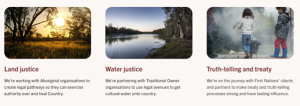
Land Justice
Environmental Justice Australia (EJA) lawyers are committed to providing legal support that enables Aboriginal and Torres Strait Islander Peoples to create new avenues for self-determination, control, and agency over their land. First Nations Peoples are the knowledge keepers of some of the oldest forms of jurisprudence on Earth, which they used to resolve conflicts, strategise for peace, and sustain relationships with Country, kin, and Ancestors. However, colonisation brought violence, war, and the disruption of Aboriginal Law and its transmission. Despite ongoing injustice and discrimination, First Nations Peoples have resisted, survived, and adapted. The law has become a focal point of resistance, serving as a framework for action as they advocate for legal recognition of their rights and interests. EJA lawyers are laying the groundwork for pathways that affirm Aboriginal authority and control over their land.
Water Justice
For tens of thousands of years, Aboriginal and Torres Strait Islander Peoples have maintained the health of rivers and waterways. Yet, since colonisation, mismanagement, over-extraction, and climate change have left these vital resources polluted and diminished. The state of Australia’s rivers is not merely an environmental crisis but a profound injustice to First Nations Peoples, who depend on healthy water for their well-being and culture. Communities along the Murray-Darling Basin have developed a concept of water management called ‘cultural flows,’ which aims to restore both life to Country and justice to First Nations communities. Cultural flows return water, rights, and management to Traditional Owners, enhancing the spiritual, cultural, natural, environmental, social, and economic conditions of their Nations. At Margooya Lagoon, Tati Tati Elders are establishing a model to turn the concept of cultural flows into a practical reality, with the hope that it will restore healthy flows to Tati Tati Country and provide a template for other First Nations communities seeking water justice (Source: Water Justice – First Nations Justice).
Truth-Telling
Additionally, EJA is committed to strengthening treaty and truth-telling processes, ensuring they have a lasting impact on First Nations clients and partners. Through these combined efforts in land justice, water justice, and truth-telling, First Nations Peoples can reclaim their rights, heal their Country, and build a more just future (Source: Truth Telling – Environmental Justice Australia)
5. Self-Audit Tool
Climate Justice Legal Needs Audit Questions for Community Service Organisations
The self-audit tool is designed to help community service organisations critically assess how they address and integrate the legal needs of their communities within the context of climate justice. By examining their current practices, policies, and strategies, organisations can identify areas for improvement and ensure they are effectively supporting the most marginalised populations affected by climate change. This process aims to enhance their proactive engagement and response to emerging legal challenges and promote a more equitable and inclusive approach to climate justice.
Note: Audit questions have been developed based on the resources Climate Justice Support Unit of the Federation of Community Legal Centres Victoria and Climate Change and Access to Justice.
Read more:
The Climate Justice Observatory provides some relevant information.
